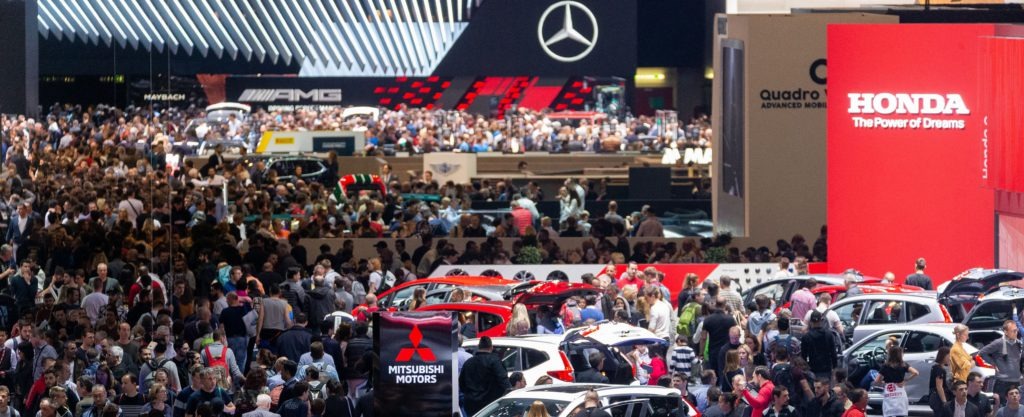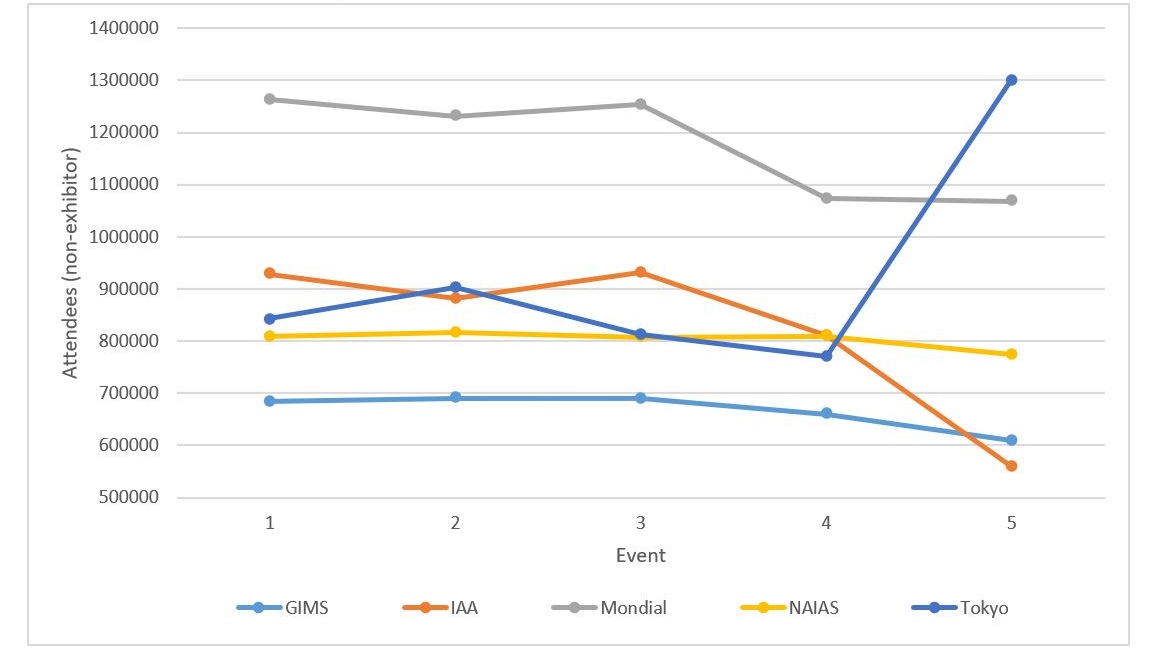Will motor shows survive after the coronavirus pandemic?
05 May 2020

5 May 2020
Over the last few years, there have been questions around the suitability of the motor show. The days of manufacturers displaying cars in a hall while the public comes to look around seem rather outdated. But will the coronavirus (COVID-19) outbreak put the final nail in the coffin of tradition? Autovista Group News Brief editor Phil Curry muses over the situation.
With a changing automotive landscape, a static-vehicle show is no longer as attractive to both carmakers and the public alike as it once was. For those who want to see a car just to speculate about a purchase, they can do so online. To sit in one, they can visit a showroom and do so without paying for a ticket.
Mobility services also mean that car ownership is no longer a necessity, and with many new, and warranted, safety features added, vehicle designs are no longer exciting, new or fresh. Many brands turn to concept vehicles to keep the public interested. However, where these once offered a potential glimpse of the future, today’s designs are so outlandish you wonder if any small component could actually be carried over to a real vehicle.
These problems mean that attendance at car shows is dropping. In the last five big shows – the Geneva International Motor Show (GIMS), Mondial Paris, IAA Frankfurt, Tokyo Motor Show and North American International Auto Show (NAIAS) – only one has been able to attract new visitors, with others suffering declines, some more severe than others.
Chart 1: Attendance at major motor shows across their last five events

Source: Various event organisers
Last year, Tokyo included areas such as ′city of the future’ and ′home of the future’ in its event, as well as incorporating lots of outdoor activities, including test drives and, making its event more of a family day out. This is something NAIAS was also planning to do in 2020, with its traditional January date moving to July to take advantage of better weather. Yet with the COVID-19 pandemic shutting events around the world, it may be some time before we know if the format change will be a success.
Coronavirus impact
It is questionable as to when mass gatherings will be permitted in exactly the same way as they were before the pandemic. While there is hope that bars, restaurants, theatres and other public venues may be able to open by the end of the year, many have suggested that life will not return to normal until a vaccine is found – a situation that could be another 12-18 months away.
This leaves motor shows, where thousands of attendees, exhibitors and staff mingle in halls with no hope of social distancing, in a no man’s land – especially when planning for next year is already underway. Such issues could result in another cancellation for GIMS, scheduled to begin on 4 March, while the first IAA in Munich during September may also be in doubt.
Then, of course, there is participation by carmakers themselves. Attending a motor show creates a substantial cost, with stand designs becoming more elaborate to rise above the competition, staffing levels increasing to field expected demand and for some, the development of concept cars to show a vision of the future.
Financial impact
COVID-19 is wreaking havoc with the global economy. Car sales in Europe plummeted 55% in March, while in April registrations in four of the big 5 markets (German figures were not available at time of writing) dropped 95%. Carmakers are struggling, even Volkswagen Group (VW), which has been able to ride out dips in the market over recent years, saw operating profits in Q1 drop by €3.9 billion. With sales forecasts suggesting a fall of 20% for annual sales in the sector over 2019 in Europe and with spending required in other areas – such as electric vehicle development – can carmakers afford to attend?
Any event that has had to cancel this year also faces trouble, as Marianne Gyger, public relations officer at Palexpo, the organiser of GIMS, explains: ′The cancellation of GIMS 2020 had a tremendous financial impact for the brands, Palexpo and the GIMS. Our first priority is to find financial solutions that suit all the stakeholders involved and allow us to have a solid basis for preparing GIMS 2021.’
Alternatives
Many potential buyers are looking to the internet for vehicle information, while the lockdowns put in place around the world to help fight COVID-19 are turning more people towards online conferencing. Video calling and webinars are becoming the ′new normal’ and carmakers have already taken advantage of this.
The cancellation of GIMS left carmakers with a lot of topics to discuss, from new model launches to technology breakthroughs. Many exhibitors decided instead to hold virtual press conferences, with Palexpo hosting a ′show’ via its website. The Car of the Year Awards event was also able to go digital.

′As the decision of the Federal Council that no major event may be held due to the COVID-19 pandemic came very shortly before the opening of GIMS, we only had a very short time to prepare for alternative scenarios,’ explains Marianne. ′Thanks to our partners and the collaboration of the involved brands we were able to set up the Car of the Year ceremony streaming without an audience and an online platform for the exhibitor press conferences within a very few days.’
Carmakers too found the change to online presentations easy. ′With our first virtual motor show launched in April following the cancellation of the Geneva Motor Show, Volkswagen has opened a new chapter for a more innovative online event format,’ says Kamila Joanna Laures, spokesperson Global Sales & Marketing at Volkswagen. ′We aimed at quickly delivering an interactive user experience embedded in a more sustainable, flexible concept. Within a few days, we have also changed our planned press conference onsite to an online show.’
The change of plans played into VW’s strategy for the future, although the carmaker is clear that an online presence must work alongside a show exhibition.
Exploiting the opportunities offered by virtual presentations is part of our digitalisation strategy,’ adds Laures. ′It will become an integral component of our experience marketing, the external presentation of the brand and our interaction with customers and fans. We are convinced that virtual events will become more and more important in reaching new audiences, complementing the real, physical presentation of vehicles.
′Our virtual motor show received great feedback from our customers, experts, and media. Click rates and streaming duration have shown that virtual presentations are most relevant for our audiences.’
Online coverage also enabled journalists to report on new models and news that would have been revealed at GIMS 2020, as you can see in Autovista Group’s alternative Geneva roundup video.
Evolve or die
The lack of shows in 2020, and possibly 2021, coupled with the global economic crisis that is looming beyond the COVID-19 recovery, leaves motor shows in a precarious position. Do not forget that the last global financial crisis in 2008 saw the end of one of the oldest events, the British International Motor Show, staged since 1903.
Organisers of events expected to take place this year will be hit financially, while those planned to take place in 2021 may yet be cancelled, and even if they do go ahead, manufacturer participation may be low as finances start to stretch. Potential buyers may be few and far between, meaning public attendance could dwindle also.
However, there is hope. With the Tokyo show increasing its visitor numbers to over 1.3 million by embracing change, adding practical zones and tangibly highlighting the future, visitor numbers may slowly rise again at other shows, should they take the same approach. One thing is for sure; the static show is no longer relevant, even more so post-coronavirus. The possibility of online launches and presentations needs to be managed effectively, perhaps with cooperation between brand and show, to reach a new, diverse audience.